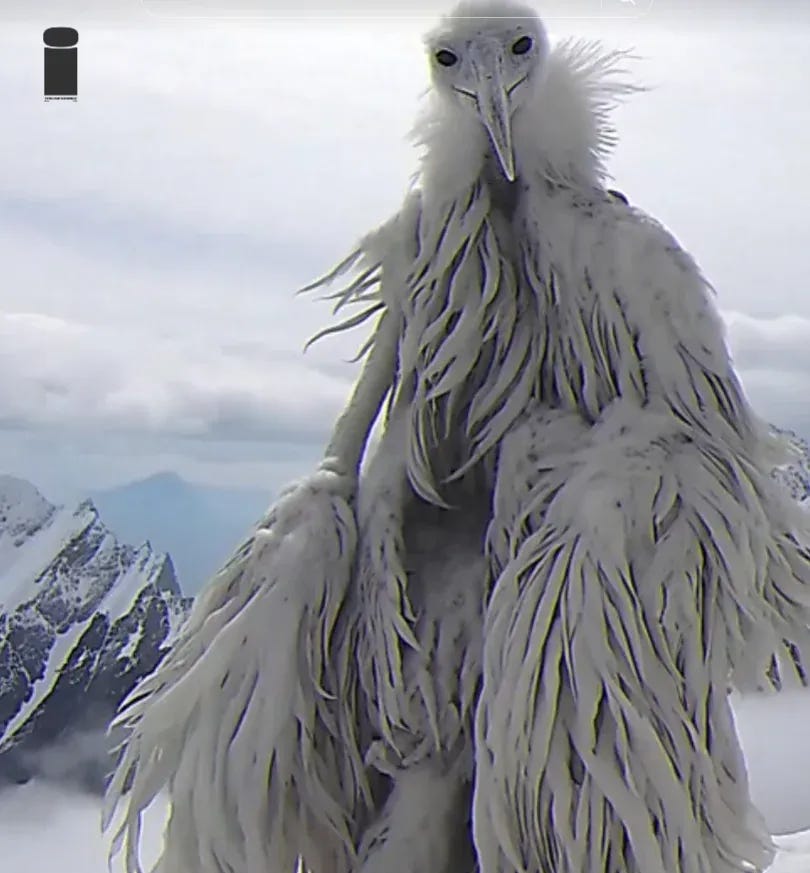The Opium Bird: How a Fake AI Creature Conquered the Internet
This oversized, feathered mystery from the icy landscapes of a fictional Antarctica has captivated TikTok, amusing and inspiring millions alike.
If you thought Bigfoot was the last great mythical beast to captivate our collective consciousness, allow me to introduce you to its digital cousin: the Opium Bird. This oversized, feathered enigma from the icy backdrops of a fictional Antarctica has taken TikTok by storm, confusing, amusing, and inspiring millions in equal measure. Created entirely by AI and planted in our minds like a particularly persistent weed, this "bird" might not exist in the real world—but it’s certainly living rent-free in the minds of those who've stumbled upon it.
Origins: From AI Experiment to Viral Sensation
The Opium Bird made its debut on TikTok on September 12, 2023, thanks to TikTok user @drevfx, who posted a series of digital images showing a towering, Bigfoot-meets-penguin-type creature standing among the frozen wastelands of an imagined Antarctica. Within days, viewers were hooked, with the video racking up over a million views.
Of course, the hashtags #AIArt and #NotReal didn’t stop anyone from speculating if this creature was, perhaps, real. After all, if the Loch Ness Monster can keep folks guessing for decades, why shouldn’t an eight-foot bird with a face only an algorithm could love stir up some modern myth-making? Enter the “Erosion Bird” nickname—because nothing screams TikTok-ready legend like rebranding a nonexistent bird with decay-centric vibes.
The Weirdcore Aesthetic: Perfect for a World on Edge
So why did a giant, feathered fictional freak show go viral in the first place? Enter the Weirdcore aesthetic. For those uninitiated, Weirdcore thrives on unsettling visuals, otherworldly landscapes, and vibes just unhinged enough to give you an existential crisis. It’s basically that feeling you get when you wander too far down an internet rabbit hole—fascination with a side of discomfort.
The Opium Bird, with its exaggerated features and eerie whiteness, taps into that Weirdcore appeal perfectly. It’s familiar enough to vaguely resemble something real, but just off enough to keep you glued to the screen. The same appeal is everywhere: distorted Y2K images, glitched-out VHS tapes, retro-futuristic vibes. People are drawn to it in times of uncertainty—because, apparently, when life feels chaotic, staring at things that feel even weirder is the perfect comfort.
Fashion and Influence: How the Opium Bird Became a Style Icon
Yes, you read that right. A mythical AI bird has somehow inspired fashion trends. Enter "luh calm fit", a TikTok term that describes a chill, stylish outfit meant to be both comfortable and, apparently, an homage to the Opium Bird’s scraggly white feathers.
Let’s pause here. If someone told you a year ago that you’d be dressing to mimic a fictional AI bird, you’d probably have laughed them off TikTok. But here we are. Maybe it’s a testament to Gen Z’s fashion sense, or maybe it’s proof that a meme can worm its way into just about every part of culture if it sticks around long enough. Either way, the Opium Bird has gone from a figment of imagination to a style influencer—something even the most ambitious influencers can only dream of.
The Cultural Impact: Why We’re All Here for Digital Hoaxes
There’s something timelessly appealing about the hoaxes of yore. From Bigfoot to crop circles, these myths have sparked curiosity, debate, and the occasional field trip for decades. But the Opium Bird is the latest in a long line of strange internet phenomena—where the only place it exists is in pixels and hashtags, yet it still feels somehow "real."
In a digital age where AI blurs reality and fiction with impressive ease, we seem drawn to these mysterious, if entirely fabricated, creatures. People love the community aspect—the shared inside joke, the memes, the "Is it real or not?" discussions. Even if we know the truth, there’s something about suspending disbelief, if only for a few minutes, that offers a bit of escapism. In other words, the Opium Bird isn't just a hoax; it's an experience.
Legacy: What the Opium Bird Tells Us About the Future of Memes
The Opium Bird’s viral run is more than just a flash in the pan; it’s a glimpse into where digital art and internet culture are headed. AI-generated content isn’t going anywhere, and as we continue to blur the lines between reality and fiction, the rise of characters like the Opium Bird will likely only increase.
What does this mean for the future of internet phenomena? Expect more "creatures" popping up in your feeds, the digital landscape littered with images of things that might be real—until you read the hashtags, that is. And as these hoaxes rise, so does the culture around them. Entire communities will rally around these bizarre icons, creating a shared language, inside jokes, and even clothing lines in homage to a creature that, lest we forget, isn’t even real.
A Final Word on the Opium Bird: Or, Why We Can’t Look Away
In a world saturated with mind-numbing amounts of content, sometimes the absurd is exactly what we need. So if you find yourself scrolling past the Opium Bird, dressed in your best "luh calm fit," don’t question it too much. Lean into the mystery. The bird might be a figment of AI’s imagination, but it’s a mirror reflecting our desire for shared experiences, inside jokes, and the occasional creepy image to break up the monotony.
Long live the Opium Bird—our digital figment, our absurd escape, and our reminder that sometimes, fiction is better than reality.





